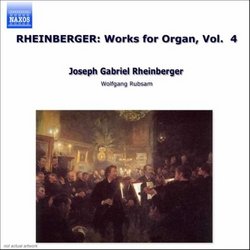| All Artists: Joseph Rheinberger, Wolfgang Rubsam Title: Rheinberger: Works for Organ, Vol. 4 Members Wishing: 0 Total Copies: 0 Label: Naxos Original Release Date: 1/1/2002 Re-Release Date: 1/15/2002 Genre: Classical Styles: Chamber Music, Forms & Genres, Sonatas, Historical Periods, Classical (c.1770-1830), Romantic (c.1820-1910) Number of Discs: 1 SwapaCD Credits: 1 UPC: 636943480922 |
Search - Joseph Rheinberger, Wolfgang Rubsam :: Rheinberger: Works for Organ, Vol. 4
 | Joseph Rheinberger, Wolfgang Rubsam Rheinberger: Works for Organ, Vol. 4 Genre: Classical
|
Larger Image |
CD Details |
CD ReviewsAll Good Things... Avid Reader | Franklin, Tn | 08/19/2003 (5 out of 5 stars) "OK OK - I admit it in this edited version. My computer went belly up and submitted multiple reviews. But in this case I think the subject is worthy of all the praise.Yes, this is currently the last recording of the Rheinberger Sonatas by Wolfgang Rubsam. It is pitiful that there is not a single collection of the Sonatas in their entirety (No 15 seems to be the hardest to locate). Again, I praise these recordings for their affordable price, the detailed liner notes, the sequential order of presentation and last (but certainly not least) the grand interpretation of a great German Romantic. The Tenth in B Minor opens broadly and again, quintessentially organist (if there is such a word - and if not there should be). It proceeds almost majestically, a mighty, solemn prelude with brief pauses. The Andante is followed by a Fantasie, this Sonata having only three movements. The opening bars set the stage for a concluding Allegro non troppo that is again punctuated with several pauses in which the composer seems to gather his forces for a final charge.The Eleventh in D Minor has long been a favorite due to its dark, infectious overflowing nature. The Agitato is another of those pieces for virtuosos only. It relaxes rarely and the massive sound recalls Widor, the gorgeous melodies, Bruckner, the conclusion, Reger. The beautiful Adagio precedes the famous Intermezzo whose ABA structure alternates between beautiful melodies and sharp chords. The final fugue begins without pause and the haunting melody intertwines with an early melody as they grow and evolve into something majestic and awe-inspiring. Needless to say, I await the next batch."
|

 Track Listings (12) - Disc #1
Track Listings (12) - Disc #1